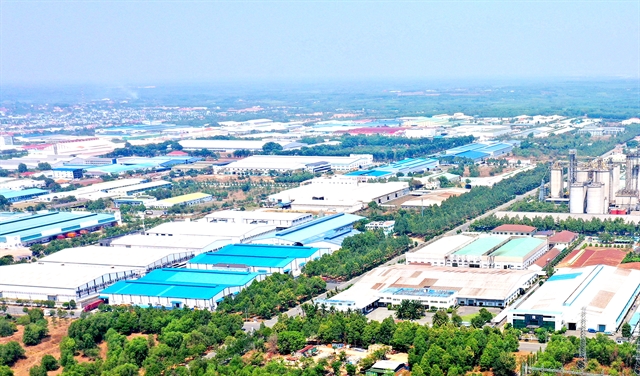 Economy
Economy

Industrial property continues to be a hot segment for Việt Nam’s real estate market with mounting enquiries as manufacturers seek to mitigate risk and diversify supply chains, according to Savills Việt Nam.

|
| Bến Cát Industrial Park in the southern province of Bình Dương. The sudden increase in lease enquiries for land, ready built factories, and warehousing has been accompanied by price escalations in industrial parks (IPs) near major cities. VNA/VNS Photo Ngọc Hà |
HÀ NỘI - Industrial property continues to be a hot segment for Việt Nam’s real estate market with mounting enquiries as manufacturers seek to mitigate risk and diversify supply chains, according to Savills Việt Nam.
The sudden increase in lease enquiries for land, ready built factories, and warehousing has been accompanied by price escalations in industrial parks (IPs) near major cities.
Average occupancy levels increasing significantly since 2018, resulting in a growing supply gap and a clear need for additional development in key industrial provinces.
In 2020, Bình Dương was almost fully occupied at 99 per cent and Đồng Nai moved up to 94 per cent. Average occupancies were 88 per cent in HCM City, 84 per cent in Long An and 79 per cent in Bà Rịa-Vũng Tàu.
In northern areas average occupancies were up to 90 per cent in Hà Nội, 95 per cent in Bắc Ninh, 89 per cent in Hưng Yên, 82 per cent in Hải Dương and 73 per cent in Hải Phòng.
Meanwhile, lease prices were up 13.1 per cent year on year to US$129 per sq.m in Hà Nội, 3.2 per cent year on year to $96 per sq.m in Hải Phòng, and 9.2 per cent to $95 per sq.m in Bắc Ninh. This price surged by 6.4 per cent to $83 per sq.m in Hưng Yên and 15.1 per cent to $76 in Hải Dương.
In Thanh Hóa Province, the very competitive land lease cost of $40–$50 per sq.m supported, in 2020, significant investment of US$349 million in total registered FDI, to rank 20th of the 60 provinces for FDI, Savills Việt Nam said.
Of which, Foxconn moving into Thanh Hóa has ramped up appeal for electronic component manufacturing, especially supporting suppliers to Foxconn. The appeal of competitive land lease prices and lower cost of local labour is further enhanced by very appealing tax incentives.
In 2020, HCM City had lease prices of $147 per sq.m, while in other southern IZs, the price was up 4.9 per cent year on year to $107 per sq.m in Bình Dương, 6.5 per cent to $98 in Đồng Nai, 7.8 per cent to $123 in Long An and 18.1 per cent to $65 in Bà Rịa-Vũng Tàu.
John Campbell, Savills Industrial Services Manager, said increasing prices and occupancy levels in key industrial zones in Việt Nam might challenge multinational businesses requiring locations near major cities like Hà Nội and HCM City.
“Rising lease prices are a growing concern for low value-added manufacturing, or low margin industries such as textiles and furniture," Campbell said. "The current rates are, for the most part, still acceptable to multinational high value manufacturers such as hi-tech, supporting industries, and automotive."
"Should prices continue on the same trajectory they have been on since 2018, regional competitiveness may slide unless more industrial land supply is deployed in key locations to accommodate demand and stabilise prices,” he said.
However, very low labour costs coupled with extremely low energy costs make operations in Việt Nam the cheapest location based upon analysis of industrial real estate at 54 markets in 21 countries, led by Hà Nội, Savills Việt Nam reported.
These low costs make Việt Nam highly attractive to multinationals setting up operations in the country, but the government is actively targeting higher value companies.
“The government has been investing heavily in all manner of infrastructure while promoting industrial clusters to attract businesses higher up the value chain,” said Troy Griffiths, Deputy Managing Director of Savills Vietnam. “High levels of corporate taxation relief are also available to ensure healthy regional competition.”
Matthew Powell, Director of Savills Hanoi, said: “Escalating demand in some provinces can also be explained by new developments, new infrastructure, new roads, ports, and airports. We have seen this phenomenon around the world, people are thinking there is light at the end of the pandemic tunnel. We are seeing increasing real estate sales in many different countries, including the UK and China.”
The Department of Economic Zone Management announced a further combined 201,000 ha over 561 new Industrial zones (IZs) are approved for master planning integration in addition to the 374 already established. Of these new IZs, the 259 utilising 86,500ha are yet to be established and represent 43.1 per cent of the total new area.
IZ infrastructure will also need to continue being improved. Policies, mechanisms, and management are continually being refined for greater efficiencies. These new projects and initiatives will be essential for accommodating the new wave of investments and industrial relocations, according to Savills Việt Nam.
Location of the new IZs is also important as most manufacturing and logistics tenants still rely on key industrial provinces or tier 1 locations. Projects in tier 2 regions will seek FDI with more competitive lease prices and vacant supply, but more investment into supporting infrastructure and intermodal transport networks are vital to the continued development of these emerging provinces. - VNS




